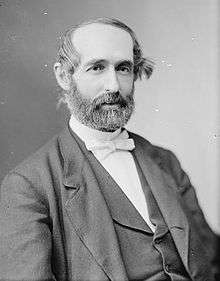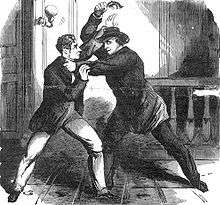Frederick W. Seward
| Frederick William Seward | |
|---|---|
 | |
| 6th & 11th United States Assistant Secretary of State | |
|
In office March 6, 1861 – March 4, 1869 | |
| President |
Abraham Lincoln (1861-1865) Andrew Johnson (1865-1869) |
| Preceded by | William H. Trescot |
| Succeeded by | J.C. Bancroft Davis |
|
In office March 16, 1877 – October 31, 1879 | |
| President | Rutherford B. Hayes |
| Preceded by | John Cadwalader |
| Succeeded by | John Hay |
| Personal details | |
| Born |
July 8, 1830 Auburn, New York, U.S. |
| Died |
April 25, 1915 (aged 84) New York, U.S. |
| Political party | Republican |
| Spouse(s) | Anna Wharton Seward |
| Profession | Lawyer, Writer, Editor, Politician |

Frederick William Seward (July 8, 1830 – April 25, 1915) was an American politician and member of the Republican Party who twice served as the Assistant Secretary of State. The son of United States Secretary of State William H. Seward, he served as Assistant Secretary from 1861 to 1869 under both Abraham Lincoln and Andrew Johnson and then from 1877 to 1879 in the administration of Rutherford B. Hayes.
Early life
Seward was born in Auburn, New York, the son of United States Secretary of State William H. Seward and Frances Adeline Seward and elder brother of General William Henry Seward, Jr..
Frederick attended the Pearl Street Academy from 1839-1940, which is located in Albany, NY; while his father was Governor of New York State.[1] He attended Union College and graduated in 1849 and was admitted to the bar in Rochester, New York in 1851.
Career
After graduating from law school, Seward served as a secretary to his father from 1849 to 1857 along with working as the associate editor of the Albany Evening Journal from 1851 to 1861.
Baltimore Plot of 1861
On February 21, 1861, Seward arrived at the Continental Hotel in Philadelphia carrying valuable information in the form of a letter from his father William Seward for President-elect Abraham Lincoln. The letter contained information gathered by Colonel Charles P. Stone and General Winfield Scott.
Colonel Stone had stationed three detectives from the New York police department in Baltimore, Maryland, to gather any information regarding a possible plot to assassinate the president-elect. Lincoln, making his way from Illinois to Washington, D.C., for his inauguration, had intended to stop next at Baltimore. According to information gathered by Colonel Stone's three detectives, secessionists were planning an attempt on Lincoln's life during his stop in Baltimore.
The information that Seward carried for Lincoln would be one of the contributing factors to Lincoln's decision to pass through Baltimore under the cover of night rather than to make stop and appear in public there. Although Allan Pinkerton also warned the President-elect of the dangers that awaited him in Baltimore, it was Seward's information that confirmed everyone's fears.
Civil War
When his father was appointed Secretary of State in 1861, Seward became Assistant Secretary of State in charge of consular service under Abraham Lincoln and Andrew Johnson. He served in this position until 1869.
Attempt on his father's life

On April 14, 1865, Frederick Seward was injured in an assassination attempt upon his father the same night Lincoln was murdered. Lewis Powell a.k.a. "Lewis Paine", an ex-Confederate co-conspirator of John Wilkes Booth attempted to kill William Seward, while the Secretary of State was convalescing at home from a carriage accident.
This was Powell's part in the plot to put the government into chaos; Vice President Andrew Johnson and President Lincoln were also to be killed that same evening. After Frederick blocked Powell from gaining access to William Seward's bedroom, Powell tried to shoot Frederick in the head. However, when the gun failed to fire, Powell quickly smashed the pistol over Seward's head, causing several skull injuries. Seward collapsed and fell to the floor at the top of the stairs.
Powell then burst into William Seward's room and stabbed him several times in the face and neck. Powell also injured a number of other bystanders, including Frederick's sister Fanny, his brother Augustus, his father's nurse Private George F. Robinson and messenger Emerick Hansell, but no one was killed. Seward's mother was sure that he was going to die; instead, she died on June 21, 1865 of a heart attack. His sister, Fanny, died soon after, in October, 1866.
Powell was hanged on July 7, 1865, along with David Herold, George Atzerodt, and Mary Surratt, who were also involved in the conspiracy.
Later life
Frederick's father died on October 10, 1872. Seward was a member of the New York State Assembly (New York Co., 7th D.) in 1875. At the New York state election, 1875, he ran on the Republican ticket for Secretary of State of New York, but was defeated by Democrat John Bigelow. He served again as Assistant Secretary of State under William M. Evarts from 1877 to 1879. Seward also edited and published his father's autobiography and letters.
Personal life
He married Anna Wharton of Albany, New York and spent the latter part of his life in a house he built in Montrose, New York. Mostly, his life after 1881 was devoted to the practice of his legal profession and to lecturing and writing.
Seward died at the age of 84. He was interred with his family in Fort Hill Cemetery in Auburn, New York.[2] In 1916, a year after his death, his book Reminiscences of a War-Time Statesman and Diplomat, 1830-1915, a five-hundred page book about the Civil War and politics, was published by G.P. Putnam's Sons.
References
- ↑ Reminiscences of a Wartime Statesman and Diplomat. G.P. Putnam's Sons, New York, 1916, p.31
- ↑ "Frederick W. Seward Buried". New York Times. April 29, 1915. Retrieved 2012-10-26.
The funeral of Frederick W. Seward, formerly Assistant Secretary of State in the cabinets of Presidents Lincoln, Buchanan and Hayes and son of Secretary ... in Fort Hill Cemetery.
Further reading
- Saving Mr. Lincoln: CIA Site by CIA 2007
- EHistory at OSU | Online Books | Battles and Leaders of the Civil War Volume 1 Page 022 at ehistory.osu.edu Battles and Leaders of the Civil War, Volume 1, Ohio State University Online
- Seward, William Henry at www.library.rochester.edu The University of Rochester Library: Rare Books and Special Collections
External links
| Wikimedia Commons has media related to Frederick W. Seward. |
| Political offices | ||
|---|---|---|
| Preceded by William H. Trescot |
United States Assistant Secretary of State March 6, 1861 – March 4, 1869 |
Succeeded by J.C. Bancroft Davis |
| Preceded by John Cadwalader |
United States Assistant Secretary of State March 16, 1877 – October 31, 1879 |
Succeeded by John Hay |